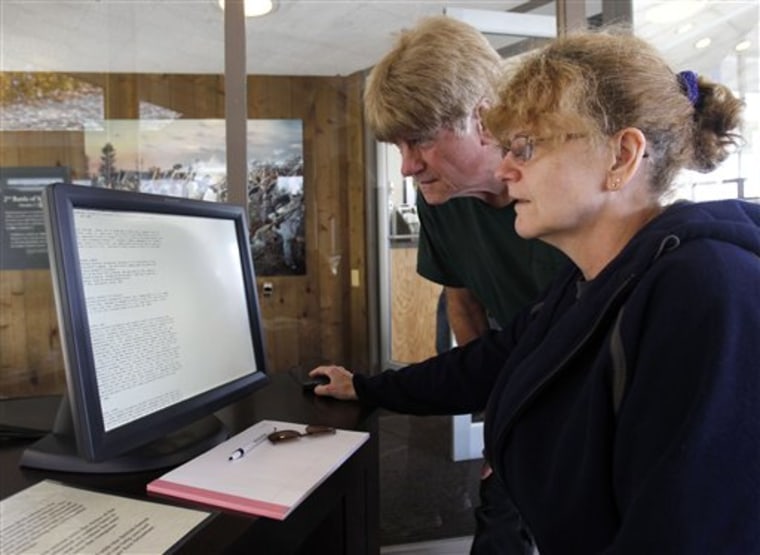Descendants of Revolutionary War soldiers who fought in one of history's most important battles can now find their American ancestors in a computer database, and some day they might be guided by GPS to the exact spots where their relatives faced musket fire, cannon barrages and bayonet charges.
History buffs spent 12 years gleaning information from 200-year-old military documents to assemble the list of thousands who participated in the Battles of Saratoga. The database, recently unveiled at Saratoga National Historical Park, contains the names of about 15,000 of the more than 17,000 soldiers of the Continental Army and various state militias who defeated the British here in 1777.
About 2,500 more American names are being added, while the names of most of the 9,000 enemy combatants — British soldiers, German mercenaries, Canadians and loyalists — are expected to join the database in several years, according to Eric Schnitzer, a National Parks Service ranger and park historian. The names of some of the Native Americans who fought here — Oneidas for the Americans, Mohawks for the British — also will be added, he said.
Tourists can search the database for names using a touch-screen computer in the park's visitor center. The list is also available on the website of Heritage Hunters, the Saratoga County-based group of volunteers who scoured 18th century regimental muster rolls and other records to compile the list.
By knowing a soldier's regiment, park rangers can help visitors find the general area on the 3,400-acre battlefield where each unit is known to have fought or been encamped, Schnitzer said. The park hopes to eventually link the database with GPS data so visitors can stand in the exact spots where their ancestor's units engaged in some of the bloodiest actions of the war.
The project was made possible by the detailed records kept by many American regiments, dispelling a common perception of America's first citizen soldiers as ragtag, undisciplined and prone to wandering about at will, Schnitzer said. Muster rolls, often updated every three months, told commanders how many men were available for duty, who they were and how much weaponry, housing and supplies they needed, he said.
"If guys were just coming and going as they wanted, like in a free-for-all, that's death to an army. That's a disaster," Schnitzer said. "That's why it wasn't done."
Members of Heritage Hunters decided in 1998 to compile a list of American participants in the Saratoga battles, said Pat Peck, a member of the group's board of trustees. The project's researchers spent tens of thousands of hours poring over 233-year-old muster rolls, pay lists and other documents in the National Archives and elsewhere, she said.
"We're not just taking the fact that you say, 'Oh, my great-great-great-grandfather was there,'" Peck said. "We're looking for something hard, firm that says, 'Yes, this person was actually at the Battles of Saratoga.'"
The digitized "muster roll" at Pennsylvania's Valley Forge National Historical Park, started on paper in the 1940s, now contains the names of more than 33,000 American soldiers who camped there in the winter of 1777-78. But Saratoga is considered unique for compiling what is someday expected to be a nearly complete list of battle participants, said one parks official.
"Saratoga is very much in the lead in getting it digitized," said James Perry, spokesman for the parks service's Yorktown Battlefield. Perry said Yorktown is in the early stages of compiling its own database.
At the Saratoga Battlefield, soldiers are listed on the database alphabetically. Each entry includes rank, regiment, length of service and home state. Some hometowns also are listed. Personal information also is included for some soldiers, including details of wartime service and names of family members.
More than 10,000 of the soldiers who fought here hailed from New England. Massachusetts led the way with 7,800, followed by New Hampshire with 1,500 and Connecticut with 1,000. Most of the rest were backwoodsmen from Virginia and Pennsylvania.
The Americans defeated an invading British force on Oct. 7, 1777, nearly three weeks after the redcoats won the first battle but couldn't advance south toward Albany because of heavy losses. After the second battle, the British force retreated several miles north before becoming surrounded. British Gen. John Burgoyne surrendered on Oct. 17 in what is now a village park along the Hudson River.
Many historians consider the American victory at Saratoga one of history's most significant battles because it persuaded France to join the fledgling United States in its fight for independence. French troops and ships later played a major role in the final defeat of the redcoats at Yorktown in October 1781.
